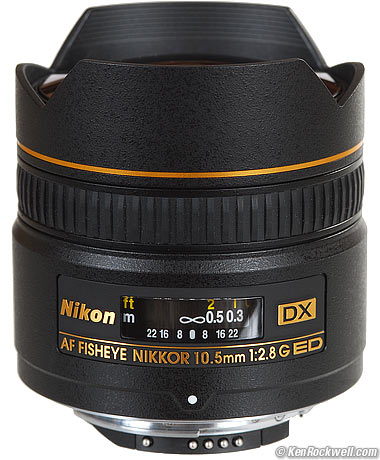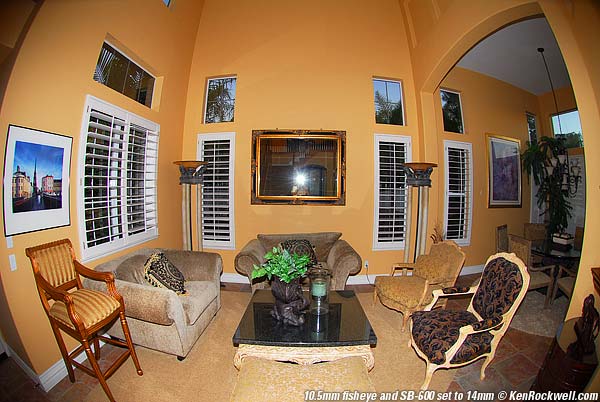|
I personally buy from Ritz, Adorama and Amazon. I can't vouch for any other ads.
|
Nikon 10.5mm Fisheye
© 2006 KenRockwell.com
Nikon 10.5mm f/2.8 DX Fisheye. enlarge.
I got mine here. I'd also get it here, here, or here. You may have to look at all the links; I had to when I got mine since it's not always in stock. It helps me keep adding to this site when you get yours from these links.
December 2006
Specifications Performance Recommendations
This is a very special $610 full-frame fisheye lens for Nikon's DX digital SLR cameras. It becomes much more practical when you use DxO or Fisheye-Hemi software to stretch the images back into something useful. I only bought my 10.5mm when I got this software.
This 10.5mm fisheye gives the same full-image results on DX digital cameras as the 16mm fisheye lenses give on FX digital and film cameras. If you have a film or FX camera like the D3, get the 16mm instead. (see also crop factor.)
No other camera maker makes such a lens for their small-format digital cameras. ; a big benefit of using Nikon digital SLRs. In Canon you have to use a full-frame 5D or 1Ds Mk II and Canon's 15mm fisheye; Canon makes no fisheyes for any of their other cameras like the 30D, 20D, 1D or Rebels. (Pentax' 10-17mm is made by Tokina.)
This 10.5mm fisheye is a DX-frame-filling fisheye lens, which means it fills the entire rectangular image with a curvy, distorted image and sees 180 degrees from corner to corner diagonally. It is not a circular image.
If you can imagine cutting a rectangle out of the center of the round fisheye image you see through a door viewer than you get the idea. This is much more useful than a circular fisheye lens which only makes a small circle in the middle of your image.
This lens is a lot of fun.
The main application of this lens is rad special effects for skateboarding and in-the-water surfing shots. Other nuts will use this for just about anything crazy. Get close to your subject and watch out. Caution: people have been killed getting too close to airplane propellers; you really will think you are further away than you really are.
The only lines that stay straight with this lens are lines or line segments that would pass through the center of the image. All other lines are bowed out away from the center.
The 10.5mm isn't for film cameras. Use the 16mm fisheye on film or full-frame sensor digital cameras.
Used on a film or FX camera the 10.5mm will have black edges. You may want to cut off the built-in lens guard to get more of the image on film, but you really should just use the 16mm fisheye instead. Even with the lens guard chopped off you still won't get a full 180 degree circle with the 10.5mm lens on a 24 x 36mm image; the diagonal of the 10.5mm lens is about a 28 mm circle.
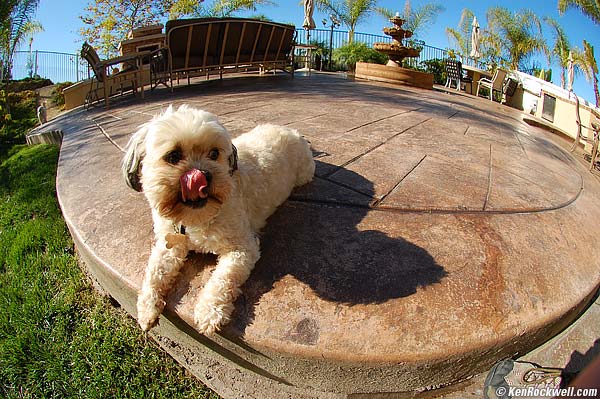
Top Intro Specifications Performance Recommendations
Introduced: 22 July 2003.
Name: Nikon calls this the Nikon DX AF Fisheye-Nikkor 10.5mm f/2.8G ED.
Optics: 10 elements in 7groups. CRC close-range correction.
Diaphragm: 7 curved blades, stopping down to f/22.
Close Focus: 5-1/2" (14 cm) from the back of the camera. This is 1.2" (3 cm) from the front of the lens, which is wild! Be careful, photographers are often killed getting too close to airplane propellers: objects in viewfinder are much closer to you than you think!
Filters: Only takes rear gel filters. This means forget about grads and polarizers unless you get creative, which indeed is the whole point of this lens.
Size: 2.5" (63 mm) around by 2.5" (64mm) long, rated.
Weight: 10.700 ounces (303.3 g), measured, no caps.
Made In: Japan.
Front Cap: Plastic slip-on, marked "61," presumably the inner diameter in millimeters. Good news: it's the same cap as the 16mm fisheyes! This is good news because I found one of these caps in a junk box in a camera store for 50 cents to use as a spare. Last I looked, about 10 years ago, Nikon extorted $50 each for them. In the good old days (1984,) these were wonderful metal caps, and sold for the same price as replacements.
Rear Cap: The usual LF-1, made in Japan.
Nikon Product Number: 2148, in catalog as of spring 2008.
Read also the press release and Nikon Japan's data here.
Top Intro Specifications Performance Recommendations
I just bought one on November 15th, 2006, and jeeze, you people want sample images already? Heck, here's one direct from my D200. No, the depth of field didn't make it all the way to my meal. This is the image reduced for your screen (you also can click it for the camera-original JPG):
La Especial Norte, Leucadia, California. D200, f/4 @ 1/15, Auto ISO 640.
Flash
Who says on-camera flash won't cover 180 degrees? I popped-down the 14mm wide diffuser down on my SB600 and here you go:
Roll your mouse over to compare SB600 with the built-in flash of the D200.
You'll have to play around for every situation. If you have walls close to you, the 14mm diffuser position will throw too much light on the walls, because they are so close. This room has 25-foot ceilings. In a normal room the built-in works well, since the ceiling is so close.
Amazingly, the built-in has little to no problem with casting a shadow at the bottom of your image. The built-in also helps not to blow out the ceiling, so try any of the built-in, and any of the diffuser or focal length settings of a hot-shoe mounted flash to get your best image.
Focusing
Focus is via two groups: the front group moves in and out and the rear group also moves in and out. Neither rotate. The outside of the lens doesn't move. The front group moves more than the rear; this optimizes the performance of the lens with distance.
AF
Traditional screw-type. Won't autofocus on a D40, but so what: just tape the focus ring to someplace between ∞ and 2 feet and you'll always be in focus.
One full turn of the AF screw brings the focus from infinity to 1 foot (30cm).
AF is fast, as you'd expect for an ultra wide lens.
Mechanics
This is very well and precisely made.
Fooled me! The front hood/protection tabs are plastic!
Everything internal seems to be metal.
LCA (Edge Color Fringes)
The 10.5mm fisheye has some secondary (green-magenta) fringes at the sides and corners.
Nikon's Capture software may have some tricks up its sleeve to correct this, but the Nikon software I've used in the past has been so buggy that I won't gamble putting it on my machine.
You can play with this in PhotoShop CS2's Lens Correction or Panorama Tools. Try something like +1 and -9 in PhotoShop CS2's Lens Correction filter for Red/Cyan and Blue/Yellow, respectively.
The 10.5mm is probably the most advanced fisheye on the market. It has an internal focusing and close-range correction system that lets it focus to a rated 5-1/2" (14cm). The interesting part is that these ratings are measured from the image plane, which is the back of the camera. Since the front of the lens is 4-1/4" (10.8cm) ahead of that, this means that the 10.5mm fisheye can focus to within 1-1/4" (3.2cm) in front of itself!
Of course with a 180 degree angle it's used, if ever, for effect and not close detail. Here's what my watch looks like that close.
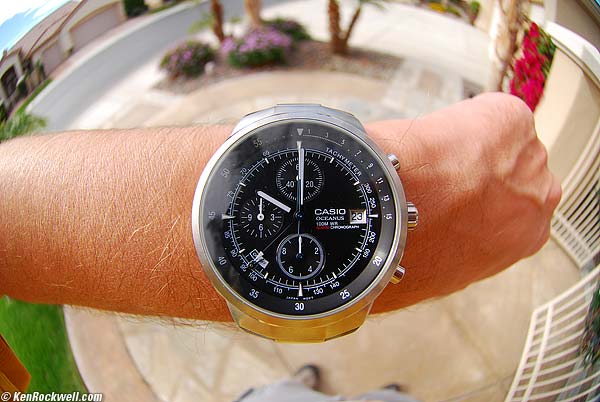
My watch from a few inches away, f/6.3.
and here's a 100% unsharpened crop from my D80:
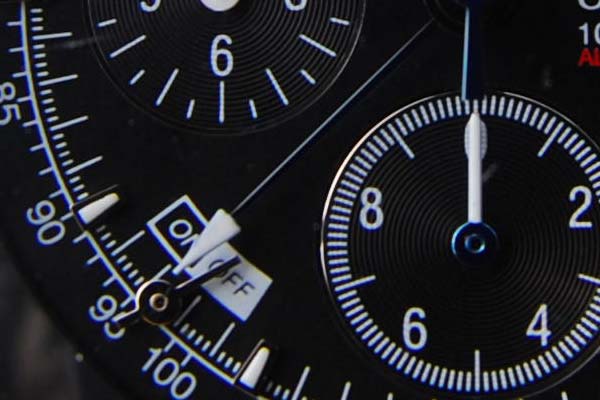
100% crop. Color fringes are from the watch crystal.
It may not look it, but this is as close as I've ever gotten with any fisheye.
Serial Number
Engraved and filled with white paint on the bottom of the barrel below "Nikon, DX ED Fisheye, Made in Japan."
Use on Film Cameras
Don't do it. Here's what happens:
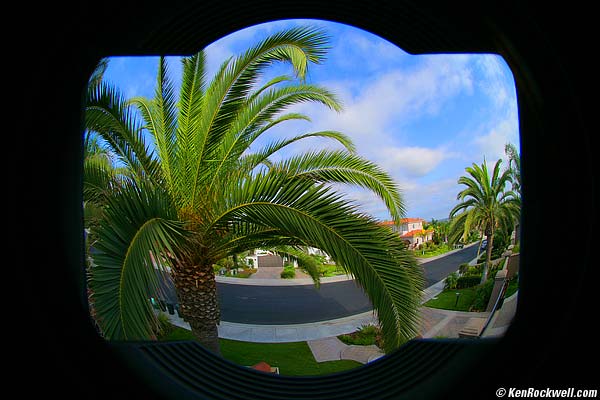
10.5mm DX fisheye shot on an FX full-frame camera.
This weird shape is how the 10.5mm's integral hood appears as seen through the fisheye.
On film and FX cameras, use the 16mm AF Fisheye. You can use either on the D3, since the D3 can be set to autocrop, but you'll get much better resolution and be using the full FX sensor for which you paid if you use the 16mm fisheye.
SOFTWARE
Get the $29.99 Fisheye Hemi converter for people pictures.
I read that the Nikon Capture software (extra cost) can perform fisheye-to-rectilinear transformations, allowing you to extract undistorted images from the center of the image.
You can do this for free using the complex Panorama Tools software available here.
Top Intro Specifications Performance Recommendations
You know if you need this. If you need it, it's most often in stock at places like Adorama so go get it!
I've never lost money on any fisheye I've ever owned. I've always bought at discount from places like Adorama, and then when I went to sell them, since no one else knows how to get them, I got more for them used than I paid! With the internet today I doubt I can get away with this anymore. I've owned three fisheyes, all 16mm: one for Minolta MD, and two for Nikon manual focus.




